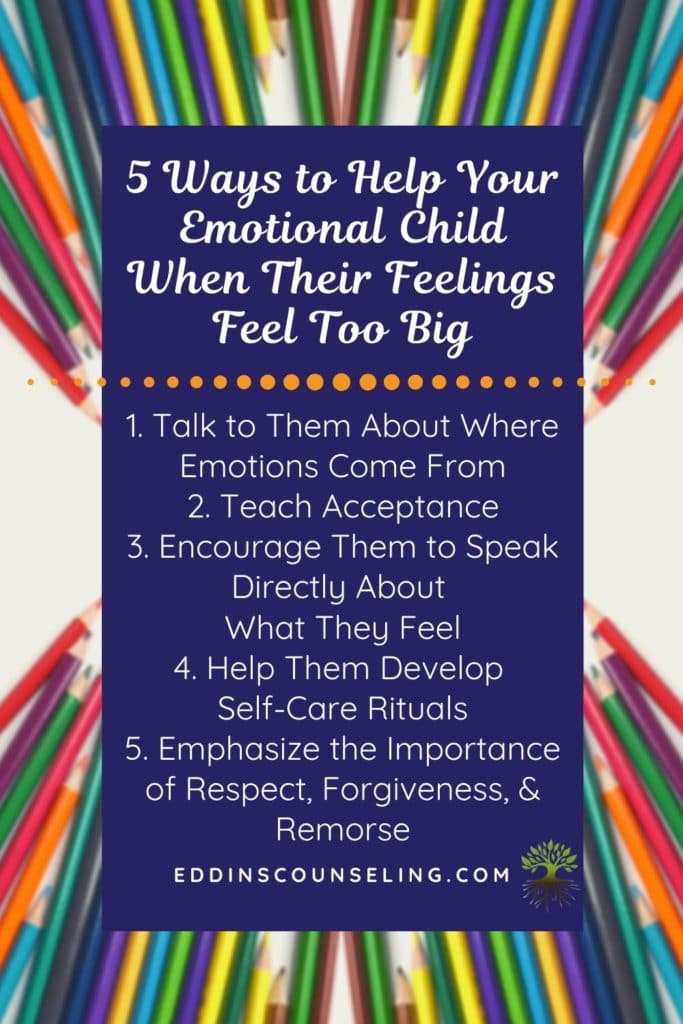March 16, 2020
Your Emotional Child: How to Help When Their Feelings Feel Too Big
Written by Rachel Eddins
Posted in Child Counseling, Parenting & Family and with tags: parenting
 The legendary Mister Rogers once wrote a song called, “What Do You Do with the Mad That You Feel?” The song taught children how to identify and manage their anger — and it pertained to all emotions. Helping your emotional child cope with challenging feelings is one of the greatest gifts — and lessons — you can ever share. As an added bonus, you as a parent get to learn some pretty neat stuff, too.
The legendary Mister Rogers once wrote a song called, “What Do You Do with the Mad That You Feel?” The song taught children how to identify and manage their anger — and it pertained to all emotions. Helping your emotional child cope with challenging feelings is one of the greatest gifts — and lessons — you can ever share. As an added bonus, you as a parent get to learn some pretty neat stuff, too.
Kids and Emotions
Absolutely no one is born with the skill and wisdom needed to control their emotions. This reality starts with the simple facts that until a certain age, children don’t even have the words they need to describe what they are feeling. Self-regulation is not even an option at that point.
Over time, your children will acquire the beginnings of both language skills and self-awareness. This will help them immensely when it comes to recognizing and articulating their emotions. But the big issue remains: What do they do with the feelings they feel?
Become a Safe Space
Before stepping up to help your kids in their time of emotional need, there are some personal steps to take. Two big ones, for example:
Resist the Urge to “Fix” Anything
Every cell in your body will be urging you to solve the problem or fix the issue. This is the emotional equivalent of out-sourcing. It will take time to empower your child with the skills needed to address big emotions. This is time well spent if you want them to grow into self-sufficient adults.
Be a Role Model of Calm Consistency
Your children feed off your energy more than you may ever imagine. Therefore, they will thrive in an environment built on a foundation of calm consistency. Practice mindfulness, stay present and become a living safe space for your kids.

5 Ways to Help Your Emotional Child When Their Feelings Feel Too Big
1. Talk to Them About Where Emotions Come From
Normalize emotions. We all have them and need them. Use examples from your child’s favorite book, TV show, or movie.
2. Teach Acceptance
Contrary to the fairy tales they read or cartoons they watch, life isn’t always “happily ever after.” Be the gentle voice of reason to help refine your kid’s expectations and, as a result, temper their outbursts.
3. Encourage Them to Speak Directly About What They Feel
Encourage your kids to speak with “I” statements. This can be accomplished by telling them what you sense, e.g. “It looks like you’re feeling mad about the way things worked out.” This can make it easier for a child to answer with directness.
4. Help Them Develop Self-Care Rituals
When we learn — at any age — to recognize and address our needs, we become better versions of ourselves. Work with an emotional child to help them help themselves.
5. Emphasize the Importance of Respect, Forgiveness, and Remorse
This is the most delicate balance of all. You cannot reflexively defend your children’s behavior. They benefit from boundaries. When they are upset, it is essential that they learn the role of forgiveness. Whenever they hurt someone else, they must under the consequences and the vital importance of learning how to sincerely apologize.
Lead By Example By Asking For Help When Needed
What do YOU do with the mad that you feel? Just like everyone else, you may have meltdowns and tantrums on your way to feeling blue. There is no shame in that. If these feelings become unmanageable, talk to a trained professional.
Regular therapy sessions are where parents can go when their own feelings feel too big. Show your emotional child that we all get emotional and never outgrow the need for support and growth. Eddins Counseling Group in Houston, TX has qualified and experienced child counselors that can help increase family connection. Call us at 832-559-2622 or book an appointment online. Please reach out, we’re here to take this journey with you.


















